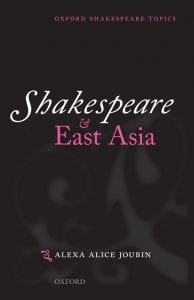Shakespeare and East Asia (2021) explores distinctive themes in post-1950s Asian-themed performances and adaptations of Shakespeare. In this Snapshot, former Fulbright Scholar Alexa Alice Joubin discusses the book and the importance of wider research into Global Shakespeares. ...continue reading "The Value of Global Shakespeare"
Tag: adaptation
Five themes in Asian Shakespeare adaptations
Since the nineteenth century, stage and film directors have mounted hundreds of adaptations of Shakespeare drawn on East Asian motifs, and by the late twentieth century, Shakespeare had become one of the most frequently performed playwrights in East Asia. There are five striking themes surrounding cultural, racial, and gender dynamics. Gender roles in the play take on new meanings in translation, and familiar and unfamiliar accents expanded the characters’ racial identities.

In her new book, Shakespeare and East Asia, Alexa Alice Joubin explores five fascinating aspects about Asian adaptations of Shakespeare’s plays.
...continue reading "Five themes in Asian Shakespeare adaptations"
Ethics of Performative Citations of Shakespeare
 Global Shakespeare can be studied through two interrelated concepts: performance as an act of citation and the ethics of citation. Appropriating the classics carries strong ethical implications. A crucial, ethical component of appropriation is one’s willingness to listen to and be subjected to the demands of others. These metaphorical citations create moments of self and mutual recognition. Seeing the others within is the first step toward seeing oneself in others’ eyes. The act of citation is founded upon the premise of one’s subjectivity, the subject who speaks, and the other’s voice that one is channeling, misrepresenting, or appropriating. ...continue reading "Ethics of Performative Citations of Shakespeare"
Global Shakespeare can be studied through two interrelated concepts: performance as an act of citation and the ethics of citation. Appropriating the classics carries strong ethical implications. A crucial, ethical component of appropriation is one’s willingness to listen to and be subjected to the demands of others. These metaphorical citations create moments of self and mutual recognition. Seeing the others within is the first step toward seeing oneself in others’ eyes. The act of citation is founded upon the premise of one’s subjectivity, the subject who speaks, and the other’s voice that one is channeling, misrepresenting, or appropriating. ...continue reading "Ethics of Performative Citations of Shakespeare"
Ophelia Unbound

How does Ophelia become “unbound” through supralinguistic structures of spectacle and music especially in a transgender performance? With case studies of three Hamlet films: Haider (India, 2004), The King and the Clown (South Korea, 2005), and Prince of the Himalayas (Tibet, 2006), this article examines theatrical and cinematic presentations of Ophelia's double bind as an icon and a victim. ...continue reading "Ophelia Unbound"

